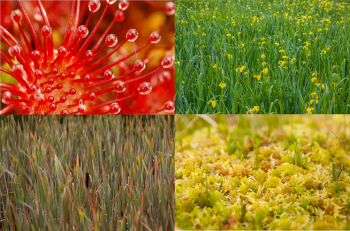News
December 2022
Paludiculture: How to and with what plants?
by Roxane Bradaczek (comments: 0)
Two new GMC publications show it

20/12/2022 You happen to have a peatland where you want to implement paludiculture, but don't know how? Convert an entire farm to "wet" agriculture - how can that be done? Or - you might be looking for the biomass from wet land for new products? For questions like these, the new Guide to Implementing Paludiculture (German only) within the GMC proceedings offers information. It aims at land managers, landowners, project sponsors, water and soil associations, government agencies, agricultural advisors, research institutions, and potential utilization companies. The guide covers five areas: Site suitability, planning and permitting for conversting sites to paludiculture, practical tips for establishment and management of sites, as well as utilisation of the biomass produced and support - including examples of implementation.
The publication Potential Paludiculture Plants of the Holarctic (English only) presents which plants are suitable for paludiculture in the Holarctic. In 440 pages, There are profiles of 95 plant species from the Database of Potential Paludiculture Plants (DPPP). Most are promising for sustainable wet land use on peatlands. Some might be considered critically since the paludiculture potential finds its limits, for example, in terms of new peat formation. In the plant portraits, comprehensive information has been compiled on the characterisation of the species, site requirements, cultivation as well as possible uses of the plant.
Source: Greifswald Mire Center
Why peatlands matter in 74 min and 4 chapters
by Roxane Bradaczek (comments: 0)
New: Online course by ZEITAkademie and GMC
8/12/2022 Peatlands as a multi-talent for climate, humans and nature – that seemed a sufficiently “burning” topic to ZEIT Akademie. In cooperation with the Greifswald Mire Centre th education provider produced an online course Peatlands as environmental protectors. It has four chapters and 74 minutes. Starring: Prof. Hans Joosten, scientist and one of the GMC’s founders, who has been awarded the German Environmental Prize in 2021 and the Federal Cross of Merit in 2022. He explains the basics on peatlands. Dr. Franziska Tanneberger describes why drained peatlands harm the climate and why we need peatland protection. The studied landscape ecologist and one of the two directors of the GMC is always in action for peatlands -from field work to world climate summits. Henning Voigt, an agricultural pioneer on peatland, takes the participants with him on his rewetted areas and tinkerer Torsten Galke invites to visit in the Paludiculture Tiny House. Dr. Johannes Merck of Michael Otto Environmental Foundation reports that even large companies do trecognise the economic potential in peatlands today. To develop a climate-friendly use of wet and rewetted areasareas is part of the toMOORow initiative, which promotes peatland rewetting as a nature-based solution to the climate crisis and species extinction, as well as an example of sustainable regional creation of added value through paludiculture.
According to its own information, ZEIT Akademie works with the best experts in their respective fields, such as the climate scientist Prof. Stefan Rahmstorf. An important argument for the two GMC scientists. "For today's challenges, science must not remain in the ivory tower. We want to teach peatlands in a non-university context as well." says Franziska Tanneberger "Of course, the quality must not be lost in and the subject must not suffer due to severe briefness. In this course, that can be combined." Another consideration: The ZEITAkademie's offerings are aimed at private individuals, but primarily at companies for in-house training. A good opportunity to foster a change in a wider public perception of peatlands - because peatlands are not scary, but incredibly important - for all of us.
Source: Greifswald Mire Center











